Common menu bar links
Breadcrumb Trail
ARCHIVED - Immigration and Refugee Board of Canada
 This page has been archived.
This page has been archived.
Archived Content
Information identified as archived on the Web is for reference, research or recordkeeping purposes. It has not been altered or updated after the date of archiving. Web pages that are archived on the Web are not subject to the Government of Canada Web Standards. As per the Communications Policy of the Government of Canada, you can request alternate formats on the "Contact Us" page.
Section 2: Analysis of Program Activities by Strategic Outcome
This section provides detailed performance information on the stated plans and expected results presented in the 2006-2007 IRB Report on Plans and Priorities. The detailed information is based on the IRB's TBS-approved PAA and MRRS.
In 2006-2007 the IRB refined the performance measurement framework associated with its PAA. The framework is supporting the IRB in its efforts to develop common tribunal performance standards and selected performance indicators, which are presented in this section for the IRB's strategic outcome as well as for the IRB's three decision-making program activities.
The 2006-2007 IRB Departmental Performance Report marks the first time that the IRB uses the complete performance measurement framework to report on its outcomes. The IRB ensures it is focused on results, delivers value for money, is consistent with federal priorities, and continues to serve the purpose and mandate for which it was created.
In 2007-2008 the IRB will update its PAA and corresponding performance management framework by rolling up the current sub-program and sub sub-program activities into its program activities. This will produce a streamlined and efficient MRRS/PAA for the IRB that will more fully comply with TBS requirements.
Common Elements
The IRB Departmental Performance Report and the IRB Report on Plans and Priorities are based on the plans and expected results presented in an annually developed IRB Integrated Business Plan. A key part of both reports is the identification of the plans and expected results of the initiatives that are common to all three decision-making program activities, which contribute primarily to the achievement of the IRB's first two strategic priorities. These plans and results are presented in the table below.
Performance Highlights and Results
Key highlights of the common activities for 2006-2007 include completion and release of major policies and/or guidelines, reporting of key performance measures, development of competency profiles for tribunal support personnel, redeployment of decision-makers, including cross-training, and an integrated international program.
Table 2.1: Common Elements Plans and Results
| Common Elements: Plans and Results for 2006-2007 |
|
| STRATEGIC OUTCOME: Provide Canadians with well-reasoned, timely decisions on immigration and refugee matters, efficiently, fairly and in accordance with the law. | |
| STRATEGIC PRIORITY Integrate common procedural, administrative and adjudicative activities in all divisions to further promote quality, consistency and efficiency measures |
|
| Plans | Results |
| Policy Instruments and Procedures | |
| Develop policies and procedures on dealing with Vulnerable Persons |
|
| Develop a standardized approach to how the IRB deals with cases involving non-disclosure of information (Section 86 cases) |
|
| Develop an IRB detention/security framework and implement selected elements across the divisions |
|
| Initiate the development of a common/shared policy on the use of videoconferencing |
|
| Performance Measures | |
| Initiate a standardized approach to present IRB performance indicators, including meaningful cross-divisional indicators, both quantitative and qualitative |
|
| STRATEGIC PRIORITY Continue to build an organizational culture that supports its people, and is flexible and innovative |
|
| Plans | Results |
| Adjudicative Culture | |
| Develop and implement IRB common guidelines and procedures on how to interface and deal with counsel conduct |
|
| Continue to implement a competency-based HR management strategy across the IRB, including developing competency profiles for functional groups and tools to support their use |
|
| Implement a policy on redeployment between the RPD and the IAD allowing increased mobility between divisions |
|
| Introduce cross-training between divisions and joint training and professional development where appropriate |
|
| Provide strategic communications advice and information that reflect changes to procedural, administrative and adjudicative activities |
|
| International | |
| Within the International Program, divisions and Operations, define respective international priorities |
|
| Coordinate international conference participation |
|
The IRB Integrated Business Plan also identifies the plans, expected results and operations that are distinct to each program activity and that contribute to achieving the IRB's strategic priorities for 2006-2007. These are highlighted in the following detailed analyses of the IRB's three decision-making program activities. The detailed analysis for the Corporate Management and Services program activity is presented in Section 4.
Refugee Protection Program Activity
|
The Refugee Protection Division delivers the IRB's Refugee Protection program activity and plays a pivotal role in enabling the Board to achieve its strategic priorities and strategic outcome. A major share of IRB resources is committed to this program activity, which is focused on rendering quality decisions in a consistent, timely manner on refugee protection claims made in Canada. |
Performance Measurements and Indicators
Table 2.2: Refugee Protection Program Activity Total Financial and Human Resources
| Financial Resources ($ millions) | ||
| Planned Spending | Total Authorities | Actual Spending |
| 86.4 | 86.3 | 81.4 |
| Human Resources (FTEs) | ||
| Planned | Actual | Difference |
| 825 | 706 | (119) |
Performance Highlights and Results
In its ongoing quest for quality and consistency in decision-making, the rpd focused on training its members on country conditions and legal issues prevailing in its top producing countries while strengthening its streamlining directions to better respond to changing claim type trends. Throughout 2006-2007, the RPD continued to render well-reasoned decisions on refugee matters despite the loss of a very large number of experienced members.
Table 2.3: Refugee Protection Program Activity Plans and Results
| STRATEGIC OUTCOME: Provide Canadians with well-reasoned, timely decisions on immigration and refugee matters, efficiently, fairly and in accordance with the law. | |
| STRATEGIC PRIORITY Integrate common procedural, administrative and adjudicative activities in all divisions to further promote quality, consistency and efficiency measures |
|
| Plans | Results |
| Distinct Elements and Tribunal Values | |
| Further monitor the RPD Action Plan in order to ensure implementation |
|
| Pursue measures to further streamline RPD processes |
|
| Further reduce pending inventory, processing times and cost by claim by monitoring and expanding the Fast Track Initiative, by reducing adjournments and postponements and through more sophisticated streamlining |
|
| Continue to implement and monitor the strategic approach to quality decision-making through quality issue sessions, discussion groups, additional National Documentation Packages (NDPs), Jurisprudential Guides and Persuasive Decisions, as needed, and Guideline 8 |
|
| Facilitate the process for making appointments and reappointments in a timely way |
|
| Develop and deliver training on various topics including state protection, delivery of reasons, exclusion and Guideline 8 |
|
| Review and deliver new member training and deliver focused training for experienced members in all areas identified by the RPD |
|
| STRATEGIC PRIORITY Improve case management processes through the successful implementation of ICMS |
|
| Plans | Results |
| ICMS Operations | |
| Development and implementation of Release 4 |
|
| Delivery of required training and simulation exercise |
|
| Post-implementation evaluation focusing on "lessons learned" carried out |
|
Quality Decisions
The 2006-2007 performance indicators for the Refugee Protection program activity are presented in the following table.
Table 2.4: Refugee Protection Program Activity Performance Indicators
| Results | Indicators | Target | Actual Value |
| Decisions are rendered in accordance with the law | Number and nature of complaints made and determined to be founded or founded in part | Stability or downward trend as % of total decisions rendered | 7 filed and 0 founded |
| Number of leaves to seek judicial review granted by the court | <1% of total decisions rendered | <1% | |
| Fair and quality decisions | Competency of decision makers | Competency of all new members assessed | All new members assessed |
| Consistency variance rate at the IRB by types of cases in top countries | <30% variance rate | <30% | |
| Consistency variance rate by country for each IRB region | <30% variance rate | <30% |
Key Outputs
The outputs for the Refugee Protection program activity are as follows:
- Claims referred
- Claims finalized
- Claims waiting
- Average processing time
- Average cost per claim finalized
Claims referred
Figure 2.1: Refugee Protection Claims Referred
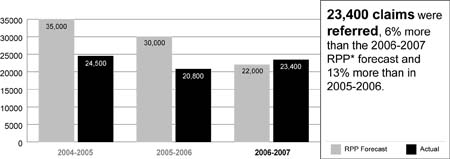
(Click on image to enlarge)
Note: The numbers have been rounded off to the nearest hundred.
*"2006-2007 RPP" refers to the 2006-2007 IRB Report on Plans and Priorities.
Mexico was the top source country in 2006-2007 with 5,490 claims referred; China was second, far behind Mexico, with 1,700 claims; and Colombia was third with 1,450 claims. Mexico accounted for 23% of all claims referred in 2006-2007, 43% above the number of claims referred in 2005-2006; this source country is the principal reason for the overall increase in referrals.
Claims finalized
Figure 2.2: Refugee Protection Claims Finalized
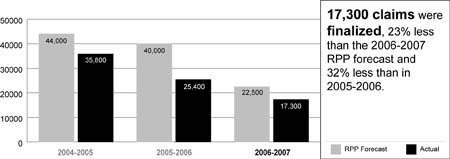
(Click on image to enlarge)
Note: The numbers have been rounded off to the nearest hundred.
The shortfall in finalizations is attributed to the fact that fewer decision-makers were appointed and reappointed than originally anticipated.
Claims waiting
Figure 2.3: Refugee Protection Claims Waiting
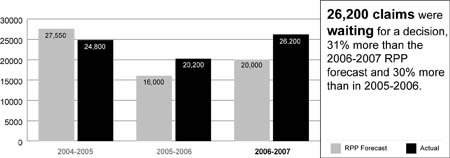
Note: The numbers have been rounded off to the nearest hundred.
The shortfall in finalizations and associated growth in the RPD's pending inventory is attributed to the lower number of decision-makers than originally anticipated. Sixty-six percent of claims waiting were nine months old or less by year end.
Average processing time
The average processing time was 11.9 months, down slightly from 12.1 months in 2005-2006 and 13.6 months in 2004-2005, but more than the forecast of 11.0 months in the 2006-2007 IRB Report on Plans and Priorities. The higher than expected average processing time was due primarily to the lower number of decision-makers than originally anticipated.
Average cost per claim finalized
The average cost per claim for 2006-2007 was $4,117 compared with $3,175 in 2005-2006. Unit costs per claim ranged from $1,600 for an expedited case to $5,700 for complex cases.
The increase in the average cost per claim is attributable to several factors including a higher share of fixed costs per unit caused by a drop in the overall IRB volume, transition costs associated with adjusting staffing levels in line with reduced business volumes, increased salary costs as a result of collective agreements and a slightly larger share of claims finalized with written decisions.
The actual cost per claim is higher than the forecasted average cost of $3,500 as reported in the 2006-2007 IRB Report on Plans and Priorities because of the factors noted above. The forecasted average cost of $3,500 was based on 22,500 projected claim finalizations while actual claims finalized were 17,300.
The cost per claim includes the decision-making costs and the costs of related activities such as case preparation, research, scheduling of hearings, legal services, foreign-language interpretation, technological support, translation services and administrative support, but it excludes extraordinary costs such as the ICMS project development costs. It also includes a share of the costs from the Corporate Management and Services program activity, which is allocated to the three decision making program activities, based on expenditure trends.
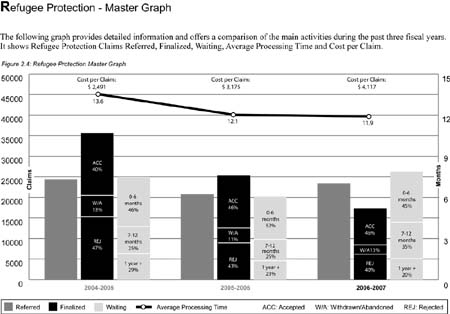
(Click on image to enlarge)
Admissibility Hearings and Detention Reviews Program Activity
|
The Immigration Division, whose members are public servants, delivers the IRB's Admissibility Hearings and Detention Reviews program activity. Admissibility hearings are held for foreign nationals or permanent residents who are alleged to be inadmissible to Canada pursuant to the provisions of the IRPA. Detention reviews are held concerning permanent residents and foreign nationals who are detained under the IRPA authority. Detainees must be seen by the Division within 48 hours and subsequent reviews must be conducted within specific timeframes set out in the IRPA. Decision-makers must balance the rights of individuals to liberty with the security interests of Canadians and persons in Canada. The number of admissibility hearings and detention reviews conducted by the IRB depends on the number of cases referred to it by the CBSA and CIC. |
Performance Measurements and Indicators
Table 2.5: Admissibility Hearings and Detention Reviews Program Activity Financial and Human Resources
| Financial Resources ($ millions) | ||
| Planned Spending | Total Authorities | Actual Spending |
| 15.2 | 15.5 | 12.2 |
| Human Resources (FTEs) | ||
| Planned | Actual | Difference |
| 90 | 92 | 2 |
Performance Highlights and Results
Over the course of 2006-2007 the admissibility hearings and detention reviews program activity coped with an increase in referrals for both admissibility hearings and detention reviews. The members of the division concluded 17% more admissibility hearings and 24% more detention reviews than in 2005-2006.
Table 2.6: Admissibility Hearings and Detention Reviews Program Activity Plans and Results
| STRATEGIC OUTCOME: Provide Canadians with well-reasoned, timely decisions on immigration and refugee matters, efficiently, fairly and in accordance with the law. | |
| STRATEGIC PRIORITY Integrate common procedural, administrative and adjudicative activities in all divisions to further promote quality, consistency and efficiency measures |
|
| Plans | Results |
| Distinct Elements and Tribunal Values | |
| Develop harmonized and informal processes to help meet the legislative timeframes and operational requirements to achieve finalization of all cases referred by the CBSA and CIC |
|
| Building on the best business practices of the IRB, introduce and implement in the ID innovative approaches to its processes |
|
| Further develop, maintain and promote tools that will support quality, consistency and efficiency in decision-making in the areas of ethics, communications, quality control and service delivery |
|
| Continue to monitor retirements in order to identify staffing requirements |
|
| Deliver focused and quality training on an ongoing basis in order to meet ID members' specific training needs and address emerging issues (including terrorism, organized crime, etc.) |
|
| Continue to implement learning culture and develop training tools |
|
Quality Decisions
The 2006-2007 performance indicators for the Admissibility Hearings and Detention Reviews program activity are presented in the following table.
Table 2.7: Admissibility Hearings and Detention Reviews Program Activity Performance Indicators
| Results | Indicators | Target | Actual Value |
| Decisions are rendered in accordance with the law | Extent to which independent internal reviewers determine that decisions made are in accordance with related legislation and jurisprudence | Develop and pilot | Not available |
| Number of leaves for judicial review granted | <1% of total decisions rendered | <1% | |
| Fair and quality decisions | Extent to which independent internal reviewers report that decisions are coherent | Develop and pilot | Not available |
| Competency of decision makers | Competency of all new members assessed upon appointment; yearly thereafter | 100% of new hires meet minimum requirements and benchmarks established (five new members) |
Key Outputs
The outputs for the Admissibility Hearings and Detention Reviews program activity are as follows
- Admissibility hearings finalized
- Detention reviews finalized
- Average cost per admissibility hearing finalized
- Average cost per detention review finalized
Admissiblity Hearings finalized
Figure 2.5: Admissibility Hearings Finalized
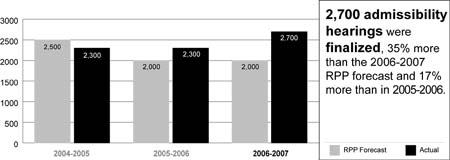
(Click on image to enlarge)
Note: The numbers have been rounded off to the nearest hundred.
Outcome of decisions:
- 71% resulted in a removal order being issued because the person was determined inadmissible
- 2% resulted in permission to enter or to remain in Canada
- 7% were subject to the withdrawal of the inadmissibility allegation by the CBSA at the hearing
- 20% of persons who received a notice to appear at their hearing failed to appear and the case was closed
Detention Reviews finalized
Figure 2.6: Detention Reviews Finalized
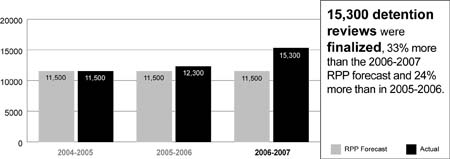
(Click on image to enlarge)
Note: The numbers have been rounded off to the nearest hundred.
The 33% variance between the 2006-2007 IRB Report on Plans and Priorities forecast and the actual number of detention reviews that were finalized is attributable mainly to changes in the case management process. These changes resulted in the inclusion of cases resolved without a decision in the total number of actual detention review finalizations.
3,634 detention reviews were finalized without a decision because the case was rescheduled or the person had been removed, released or detained by the courts prior to a scheduled review. 11,626 detention reviews were finalized with a decision.
Outcome of detention reviews finalized with a decision:
- 74% resulted in continued detention
- 18% resulted in an order for release on terms and conditions subject to bond*
- 5% resulted in an order for release on terms and conditions not subject to bond*
- 3% resulted in other decisions (e.g., change in conditions)
* Note: In 2006-2007 the ID began reporting on two types of orders for release on terms and conditions.
Average cost per admissibility hearing and detention review finalized
The average cost per admissibility hearing finalized was $1,133 and the average cost per detention review finalized was $751. These costs are slightly higher than the 2005-2006 average costs of $1,015 for an admissibility hearing and $710 for a detention review. The increase in average costs is mainly attributable to higher salary costs and a higher share of fixed costs per unit caused by a drop in the overall IRB volume. In the 2006-2007 IRB Report on Plans and Priorities, the forecasted cost per admissibility hearing was $1,100 and $800 per detention review.
The cost per admissibility hearing and detention review includes the decision making costs and the costs of related activities such as case preparation, scheduling of hearings, legal services, foreign-language interpretation, technological support, translation services, transcribing services and administrative support. It also includes a share of the costs from the Corporate Management and Services program activity, which is allocated to the three decision-making program activities, based on expenditure trends.
Figure 2.7: Admissibility Hearings Master Graph
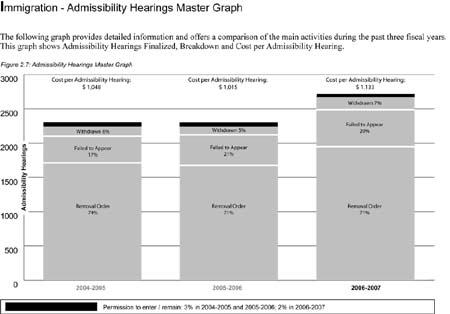
(Click on image to enlarge)
Figure 2.8: Detention Review Master Graph
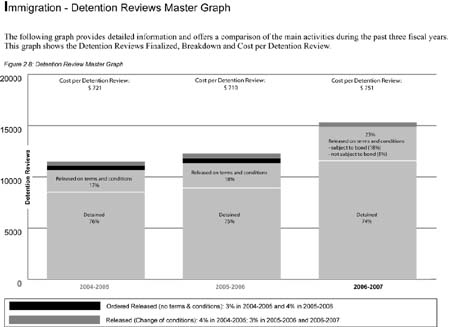
(Click on image to enlarge)
Immigration Appeal Program Activity
|
The Immigration Appeal Division delivers the IRB's Immigration Appeal program activity. It hears immigration appeals from Canadian citizens and permanent residents whose applications to sponsor close family members to Canada have been refused. Other key functions include hearing appeals from permanent residents, foreign nationals with a permanent resident visa, protected persons who have been ordered removed from Canada and permanent residents outside of Canada who have not fulfilled their residency obligation. |
Performance Measurements and Indicators
Table 2.8: Admissibility Hearings and Detention Reviews Program Activity Financial and Human Resources
| Financial Resources ($ millions) | ||
| Planned Spending | Total Authorities | Actual Spending |
| 15.2 | 17.5 | 16.8 |
| Human Resources (FTEs) | ||
| Planned | Actual | Difference |
| 135 | 144 | 9 |
Performance Highlights and Results
2006-2007 was a year of transformation for the IAD. Improvements in case management and adjudicative support were achieved through the continued implementation of the iad innovation initiative, which included expanded streaming of appeals into the appropriate case processes and the transition of the alternative dispute resolution program to tribunal officers who are public service employees. These changes increased the capacity of IAD members to focus on hearing and deciding more appeals. As a result, the division achieved a record-high number of appeal finalizations despite a shortfall in members.
Table 2.9: Immigration Appeal Program Activity Plans and Results
| STRATEGIC OUTCOME: Provide Canadians with well-reasoned, timely decisions on immigration and refugee matters, efficiently, fairly and in accordance with the law. | |
| STRATEGIC PRIORITY Integrate common procedural, administrative and adjudicative activities in all divisions to further promote quality, consistency and efficiency measures |
|
| Plans | Results |
| Distinct Elements and Tribunal Values | |
| Ensure the implementation of major transformation through IAD Innovation; this initiative is ongoing and is expected to lead to significant changes to IAD's case processes and hearings |
|
| Review ADR practices and procedures and case selection |
|
| Expand and improve early review process |
|
| Facilitate the process for making appointments and reappointments in a timely way |
|
| Develop innovative approach to obtain more information from both parties earlier to support earlier screening, streaming and resolution |
|
| Ensure that members take more proactive control of the hearing process |
|
| Analyze nature and scope of adjournments and postponements and develop action plans to reduce the postponement/adjournment rate |
|
| Review ADR in-house training |
|
| Develop customized training plan for new members (if necessary) |
|
Quality Decisions
The 2006-2007 performance indicators for the Immigration Appeal program activity are presented in the following table.
Table 2.10: Immigration Appeal Program Activity Performance Indicators
| Results | Indicators | Target | Actual Value |
| Decisions are rendered in accordance with the law | Extent to which independent internal reviewers determine that decisions made are in accordance with related legislation and jurisprudence | Decline in number of decisions that raise legal concerns | Unknown |
| Number of leaves for judicial review granted by the Federal Court; and number of IAD decisions overturned | <1% | <1% | |
| Fair and quality decisions | Extent to which internal independent reviewers determine that decisions and reasons meet quality standards (well-reasoned, well-written and understandable) | Decline in number of decisions and reasons that fail to meet quality standards | Unknown (quality standards not yet established) |
| Competency levels and appraisals of decision makers | All members are assessed as competent; increase in performance appraisal ratings | Unknown | |
| Extent to which external feedback indicates the processes are fair, accessible, transparent and efficient | Increase in positive external feedback | Unknown |
Key Outputs
The outputs for the Immigration Appeal program activity are as follows
- Appeals filed
- Appeals finalized
- Appeals waiting
- Average processing time
- Average cost per appeal finalized
Appeals filed
Figure 2.9: Immigration Appeals Filed
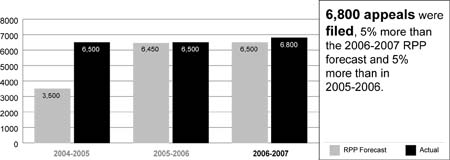
(Click on image to enlarge)
Note: The numbers have been rounded off to the nearest hundred.
The number of filed appeals remained high because of an increase in sponsorship appeals, which comprise an increasing proportion of the IAD caseload.
Appeals finalized
Figure 2.10: Immigration Appeals Finalized
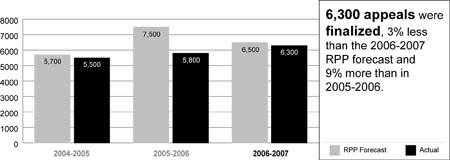
(Click on image to enlarge)
Note: The numbers have been rounded off to the nearest hundred.
The 6,300 appeals finalized in 2006-2007 is the highest number of immigration appeals finalized in a given year in the history of the IAD. Contributing to this increased level of performance was the continued high productivity of members and the transition of the ADR program to the public service. The latter activity, which saw public service employee Dispute Resolution Officers in place in most regions by the final quarter of the year, enabled available members to focus solely on deciding those appeals that must proceed to a hearing for resolution.
The increased and successful use of the ADR program (20% more appeals were resolved through ADR in 2006-2007 than in 2005-2006), early review processes and increased focus on the screening and streaming of cases were key mechanisms by which the IRB managed its immigration appeals caseload-all of which had a positive impact on productivity.
Although the IAD successfully increased its productivity-9% over the previous fiscal year-the IAD fell short by 3% of the finalization forecast in the 2006-2007 IRB Report on Plans and Priorities. This shortfall was due largely to the fact that the IAD did not see an increase in its member complement, an assumption on which the forecast was initially based. Delays in appointments and reappointments in all regions contributed to the shortfall in finalizations. The forecasts in the 2006-2007 IRB Report on Plans and Priorities were based on a member complement for the IAD of more than 37 members, but the Division's complement declined from 32 members early in the fiscal year to 26 by March 2007.
Outcome of decisions:
- 43% were allowed and 31% were dismissed
- 26% were withdrawn by the appellant or declared abandoned by the IRB
Appeals waiting
Figure 2.11: Immigration Appeals Waiting
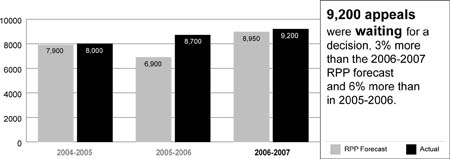
(Click on image to enlarge)
Note: The numbers have been rounded off to the nearest hundred.
The increase is a direct result of the number of appeals filed exceeding the number of appeals finalized for a fifth consecutive year; however, the proportion of appeals finalized to appeals filed increased to 93% in 2006-2007 from 86% in 2005-2006.
Average processing time
The average processing time increased by 8% to 9.9 months in 2006-2007 compared to 9.2 months in 2005-2006. The increase is due primarily to the fact that the high number of appeals filed continues to exceed the capacity of the IAD to hear and finalize them.
Average cost per appeal finalized
The average cost per finalized appeal for 2006-2007 of $2,260 is slightly higher than the 2005-2006 adjusted actual average cost of $2,130 primarily as a result of a higher share of fixed costs per unit caused by a drop in the overall IRB volume and higher translation costs. Average unit costs per appeal ranged from $2,200 for sponsorship appeals to $2,500 for removal orders and residency obligation appeals.
The average cost per finalized appeal is slightly higher than the forecasted cost of $2,100 as reported in the 2006-2007 IRB Report on Plans and Priorities as a result of higher translation costs and an increased share of infrastructure costs.
The cost per appeal includes decision-making costs and the costs of related activities such as case preparation, research, scheduling of hearings, legal services, foreign language interpretation, technological support, translation services and administrative support, but it excludes extraordinary items such as the IAD Innovation initiative costs. It also includes a share of the costs of the Corporate Management and Services program activity, which is allocated to the three decision making program activities, based on expenditure trends.
Figure 2.12: Immigration Appeal Master Graph
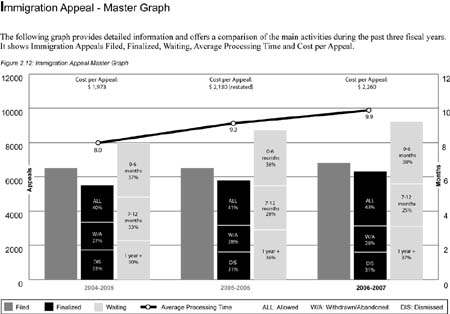
(Click on image to enlarge)
